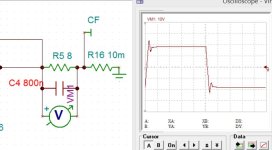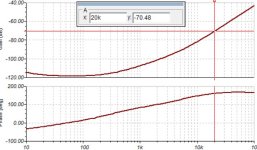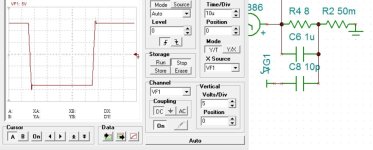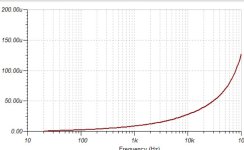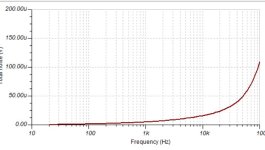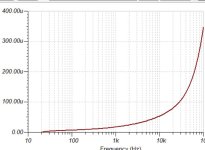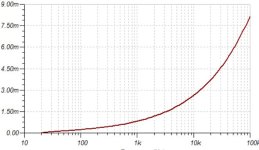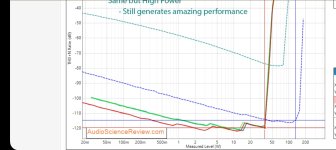H
HAYK
H
HAYK
I have a working model on the bench, the simulator guides me what can be done but not what should be done.
When something goes good in simulation, it can only be simulation fantasy, when it goes bad it can only be the circuit.
Which parameter of the DS is not accurately modeled?
Look at at Neochrome website, there is only simulation.
The load current do you mean be infected by the power supply noise?
I am reviewing from the start the stability of the 2 loops, something much better to come.
When something goes good in simulation, it can only be simulation fantasy, when it goes bad it can only be the circuit.
Which parameter of the DS is not accurately modeled?
Look at at Neochrome website, there is only simulation.
Would this also be immune to power supply quality?
The load current do you mean be infected by the power supply noise?
I am reviewing from the start the stability of the 2 loops, something much better to come.
H
HAYK
H
HAYK
I found a nice way of replacing the AD829 with NE5534 in error subtracting circuit. I reduce the gain of the opamp by using the compensation path which gives an internal VAS feedback. I get 70db NFB @20khz.
C1 is for the sake of simulating correctly. I just adjusted R8 to 33k for perfect square wave.

C1 is for the sake of simulating correctly. I just adjusted R8 to 33k for perfect square wave.
Attachments
Note that nothing power supply related is included in the LM3886 model. In fact, if you run it at, say, 40 W into 8 Ω in simulation, the supply current remains at 55 mA. That's rather impossible in reality. #knowYourModels. 🙂
Tom
Tom
H
HAYK
Post in thread 'LM3886 Stereo Amplifier and Power Supply Design' https://www.diyaudio.com/community/...r-and-power-supply-design.409952/post-7622730
H
HAYK
H
HAYK
Estimating the performance of the error corrector and the error subtractor.

The 3886 alone has a noise at 10mw 0.03% with 8 ohm, hence with 4 ohm it gets the same at 20mw because the output voltage becomes the same as 8ohm 10mw. It is nearly the same THD+N for 1w 8ohm and 2w 4ohm. In other words, the noise is the main value in THD+N at this range.
With Modulus-86, the story is rather strange.

The noise is reduced to 0.006% for both 4ohm and 8ohm which is 5 times less for 8 ohms than normal 3886. But strangely, the noise is 1.4 times lower if 4 ohms load as it has the same percentage, doubtful isn't it? On the other hand the max power for 4 and 8 ohm are nearly the same, is there 4-8 ohms switch?
If I compare on simulator what I get, the LM3886 alone has 3.5mv output noise for 20h-20khz BW. With error subtractor it is 80uv, with error corrector, it is 24uv 1k and 50uv 10k resistor for volume control.
This means I get 42 times less noise with error subtractor and up to152 times with error corrector.
The 3886 alone has a noise at 10mw 0.03% with 8 ohm, hence with 4 ohm it gets the same at 20mw because the output voltage becomes the same as 8ohm 10mw. It is nearly the same THD+N for 1w 8ohm and 2w 4ohm. In other words, the noise is the main value in THD+N at this range.
With Modulus-86, the story is rather strange.
The noise is reduced to 0.006% for both 4ohm and 8ohm which is 5 times less for 8 ohms than normal 3886. But strangely, the noise is 1.4 times lower if 4 ohms load as it has the same percentage, doubtful isn't it? On the other hand the max power for 4 and 8 ohm are nearly the same, is there 4-8 ohms switch?
If I compare on simulator what I get, the LM3886 alone has 3.5mv output noise for 20h-20khz BW. With error subtractor it is 80uv, with error corrector, it is 24uv 1k and 50uv 10k resistor for volume control.
This means I get 42 times less noise with error subtractor and up to152 times with error corrector.
Attachments
Last edited by a moderator:
The topping LA90 also use the LM3886 and it achieved even lower noise floor.
Highest SINAD on the ASR chart to date.
Isn't that the point of composite amplifier?
Highest SINAD on the ASR chart to date.
Isn't that the point of composite amplifier?
H
HAYK
I think this amplifier idea would do well if sold as a board / kit, provided the measurements are comparable to the OP's simulated results.
The ZD-50 circuit uses stabilized power. When unstabilized, the parameters are worse.You can also compare the ZD-50 and myref results.
Why use other power then?The ZD-50 circuit uses stabilized power. When unstabilized, the parameters are worse.
Do you mean worse than original 3886?
This is a question for @tomchrEstimating the performance of the error corrector and the error subtractor.
View attachment 1285092
The 3886 alone has a noise at 10mw 0.03% with 8 ohm, hence with 4 ohm it gets the same at 20mw because the output voltage becomes the same as 8ohm 10mw. It is nearly the same THD+N for 1w 8ohm and 2w 4ohm. In other words, the noise is the main value in THD+N at this range.
With Modulus-86, the story is rather strange.
View attachment 1285093
The noise is reduced to 0.006% for both 4ohm and 8ohm which is 5 times less for 8 ohms than normal 3886. But strangely, the noise is 1.4 times lower if 4 ohms load as it has the same percentage, doubtful isn't it? On the other hand the max power for 4 and 8 ohm are nearly the same, is there 4-8 ohms switch?
If I compare on simulator what I get, the LM3886 alone has 3.5mv output noise for 20h-20khz BW. With error subtractor it is 80uv, with error corrector, it is 24uv 1k and 50uv 10k resistor for volume control.
This means I get 42 times less noise with error subtractor and up to152 times with error corrector.
Alongside with this question:
- is it legit to work on a clone of Modulus (as doing on other amps)?
- would this violate the forum rules?
Cheers
There're many cloned amps on this forum, so I doubt that's a huge issue. There are also other composite amplifiers here that use the LM3886, so designing another one is not in and of itself an issue. I would take issue if someone designed a circuit and marketed it as a Modulus amp or as a Neurochrome product. But that's not what's going on here either. I would also take issue with someone posting my design documentation as their own.
There's nothing to stop someone from designing a composite amp based on the LM3886 ... and there shouldn't be. And if they want to share their thoughts here, have at it. I wish they would come up with their own name for it, but on the other hand imitation is the greatest form of flattery. Or at least it can be perceived that way.
I know the LM3886 well enough to know that there's a big difference between getting an amp to work well in the simulator and getting the same design to work well in reality. I've said as much, repeatedly, to OP but he hasn't been too interested in listening so it seems silly to keep reiterating that point. I've yet to see any measured data on any of the amp designs shown in this thread.
Tom
There's nothing to stop someone from designing a composite amp based on the LM3886 ... and there shouldn't be. And if they want to share their thoughts here, have at it. I wish they would come up with their own name for it, but on the other hand imitation is the greatest form of flattery. Or at least it can be perceived that way.
I know the LM3886 well enough to know that there's a big difference between getting an amp to work well in the simulator and getting the same design to work well in reality. I've said as much, repeatedly, to OP but he hasn't been too interested in listening so it seems silly to keep reiterating that point. I've yet to see any measured data on any of the amp designs shown in this thread.
Tom
@tomchr
Thanks for reply
Thanks for support in this forum
Thanks for had designed Modulus and improved since that.
I totally agree with last point.
I agree about imitation - adulation.
I think if someone that bought your modulus starts a thread called TOM CHRISTIANSEN'S MODULUS-86 CLONE AMP and he replicate your scheme 1:1, maybe changing 1 resistor, that would be a bit bigger issue, isn't it?
If not, your scheme would be public.
And since your price are fair and competitive, this shouldn't be a problem...
As you do reverse engeneering on your competitors (cmon be honest! 🙂 ), others do that on your products.
Have a nice day, your modulus is the cheapest reference audiophile amp! Score100

Thanks for reply
Thanks for support in this forum
Thanks for had designed Modulus and improved since that.
I totally agree with last point.
I agree about imitation - adulation.
I think if someone that bought your modulus starts a thread called TOM CHRISTIANSEN'S MODULUS-86 CLONE AMP and he replicate your scheme 1:1, maybe changing 1 resistor, that would be a bit bigger issue, isn't it?
If not, your scheme would be public.
And since your price are fair and competitive, this shouldn't be a problem...
As you do reverse engeneering on your competitors (cmon be honest! 🙂 ), others do that on your products.
Have a nice day, your modulus is the cheapest reference audiophile amp! Score100
- Home
- Amplifiers
- Chip Amps
- Error Corrected Chip Amplifiers, aka Modulus Clone
